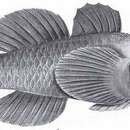en
names in breadcrumbs


The Redhead Goby,Paragobiodon echinocephalus, is a small fish with a black body and fins and a large red-orange head that is covered in soft, short bristles.It is found in coral reefsfrom the Red Sea and Madagascar in the West to Japan, Polynesia and Australia in the East (Herre 1936, Masuda et al. 1984,Randall et al. 1990,Allen & Adrim 2003). This gobyinhabits live heads of scleractinian corals, in particular, thehood coral, Stylophora pistillata(Kuwamura et al. 1994a, Herler & Hilgers 2005,Belmaker et al.2007, Herler 2007). It has also been found in association with the cauliflower coral,Pocillopora damicornis(Lassig 1977) and the small staghorn coralAcropora nasuta(Dixson & Hay 2012). The fishes rely on their coral host for food, shelter from predation, and breeding sites.
Redhead gobies may live in a coral singly, in pairs, or in groups, with larger coral generally hosting larger groups of fishes. Within an individual coral, only the largest two fish will breed(Kuwamura et al. 1993). After the female spawns on the coral, the father will guard the eggs until they hatch(Kuwamura et al. 1993).
Like many reef fishes, redhead gobiesare capabable of changing sex (sequential hermaphroditism). But unlike most sequential hermaphrodites who change sex only once during their lifetime,P. echinocephalusmay change sex repeatedlyin either direction (Nakashima et al. 1995). In fact, the phenomenon of multiple changes from female to male or male to female (serialhermaphroditism) was first described in this species (Kuwamura et al. 1994b).
Dixson and Hay (2012) documented a remarkable mutualistic relationship between the staghorn coral Acropora nasuta and the Redhead Goby (Paragobidon enchinocephalus), which is recruited by the coral to keep it free of Turtleweed (Chlorodesmis fastigiata). Within minutes of Turtleweed (or even a chemical extract from the Turtleweed) contacting the coral, the coral releases an odor that recruits gobies to trim the Turtleweed and dramatically reduce coral damage that would otherwise occur. Interestingly, in contrast to the other goby species shown to play a similar role (the Broad-barred Goby, Gobiodon histrio) the Redhead Goby does not consume the Turtleweed it removes.
New research reveals that corals send out chemical signals to recruit the help of Goby fish in removing toxic seaweed.